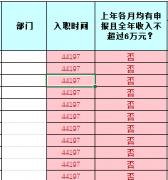问题描述
在 Laravel 5 中,是否可以验证多个请求以便在表单提交后插入相关模型?
我知道如何使用验证器验证多个模型,但我想使用请求类来验证.
is it possible, in Laravel 5, to validate multiple Requests in order to insert related models after a form submission?
I know how to validate multiple Model by using Validators but I want to do it with the Request Class.
$validateUser = Validator::make(Input::all(), User::$rules);
$validateRole = Validator::make(Input::all(), Role::$rules);
if ($validateUser->fails() || $validateRole->fails()){
$validationMessages = array_merge_recursive(
$validateUser->messages()->toArray(),
$validateRole->messages()->toArray()
);
}
Laravel 5:
请求一个
class CreateUserRequest extends Request {
public function rules()
{
//
}
}
请求两个
class CreateRoleRequest extends Request {
public function rules()
{
//
}
}
控制器模型调用:
public function store(CreateUserRequest $request, CreateRoleRequest $request2)
{
//
}
如何使用请求方法验证用户输入值和角色输入值?(并在验证失败时提供特定反馈)
How can I validate the User input values and the Role input values using the Request approach? (and have a specific feedback if validation fails)
推荐答案
首先,使用多个表单请求类非常好.
First, using multiple form request classes works perfectly fine.
当然,您不能将两种形式合二为一.但是,您可以对字段名称使用数组语法来分隔数据:
Now of course you can't just have two forms in one. However what you can do to separate your data, is to use the array syntax for field names:
<input type="text" name="user[name]" />
<!-- and later -->
<input type="text" name="role[name]" />
在您的验证规则中,您可以使用点语法来引用用户名或角色名:
In your validation rules you can then use the dot syntax to reference either the user name or the role name:
public function rules(){
return [
'role.name' => 'required'
];
}
为了创建两个模型,只需使用它来获取 user 和 role 的所有属性:
And for creating the two models, just use this to get all the attributes for user and role:
$request->input('user'); // returns an array like ['name' => 'foo', 'other-user-field' => 'bar']
$request->input('role'); // returns an array like ['name' => 'baz', 'other-role-field' => 'boom']
这篇关于Laravel 5 - 验证多个请求的文章就介绍到这了,希望我们推荐的答案对大家有所帮助,也希望大家多多支持跟版网!



 大气响应式网络建站服务公司织梦模板
大气响应式网络建站服务公司织梦模板 高端大气html5设计公司网站源码
高端大气html5设计公司网站源码 织梦dede网页模板下载素材销售下载站平台(带会员中心带筛选)
织梦dede网页模板下载素材销售下载站平台(带会员中心带筛选) 财税代理公司注册代理记账网站织梦模板(带手机端)
财税代理公司注册代理记账网站织梦模板(带手机端) 成人高考自考在职研究生教育机构网站源码(带手机端)
成人高考自考在职研究生教育机构网站源码(带手机端) 高端HTML5响应式企业集团通用类网站织梦模板(自适应手机端)
高端HTML5响应式企业集团通用类网站织梦模板(自适应手机端)